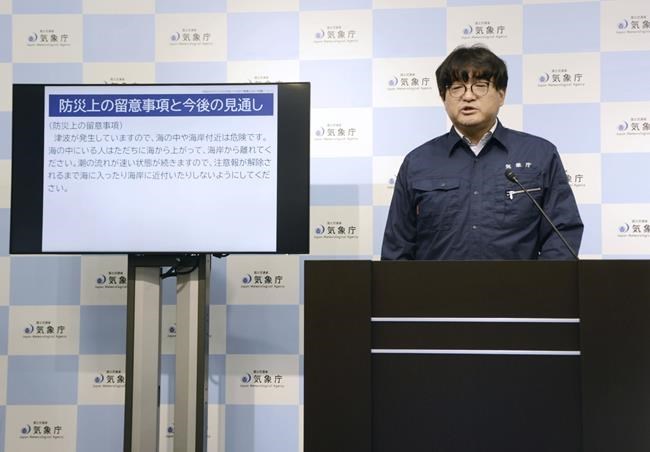
An official for the Japan Meteorological Agency speaks during a news conference in Tokyo, Tuesday, Sept. 24, 2024, following its observation of about 20-inch (50-centimeter) tsunami on Hachijo Island of the Izu and Ogasawara island chains, which occurred after an earthquake. (Kyodo News via AP)
Republished September 23, 2024 - 9:25 PM
Original Publication Date September 23, 2024 - 5:11 PM
TOKYO (AP) — Small tsunami waves splashed ashore on remote Japanese islands Tuesday morning after an earthquake that may have been triggered by volcanic activity.
The offshore quake was not felt, and the tsunami advisory was lifted about three hours later. No damage or injuries were reported.
The Japan Meteorological Agency had advised that waves up to 1 meter (yard) above tide levels could occur on the coasts of the Izu and Ogasawara island chains after the magnitude 5.8 quake occurred off the Izu Islands. The U.S. Geological Survey measured the quake's strength at 5.6 magnitude.
About 21,500 people live on the islands in the Izu group and about 2,500 on the Ogasawara Islands.
JMA said a tsunami of about 50 centimeters (about 20 inches) was detected in the Yaene district on Hachijo Island about 30 minutes after the quake. Smaller waves were detected on three other islands — Kozushima, Miyakejima and Izu Oshima.
The offshore quake occurred about 180 kilometers (111 miles) south of Hachijo island, which is about 300 kilometers (186 miles) south of Tokyo.
Television footage showed waves splashing against a wharf on Hachijo island but no major swelling was seen.
Residents on Hachijo said they did not feel the quake and only heard the tsunami advisory, Japan's NHK public television said.
Ryuji Minemoto, a Hachijo resident, told NHK that he was on high ground overlooking the ocean but didn't notice changes in the water. “I can see some ships but they don't seem to be moving violently,” he said. Minemoto said he did not feel the earlier quake.
Fumihiko Imamura, a Tohoku University seismologist, said the tsunami is believed to be related to undersea volcanic activity that might have caused a rise or sinking of parts of the seabed. Imamura told NHK that such movement, unlike ordinary quakes, may not have caused rattling.
Japan sits on the Pacific “Ring of Fire,” a line of seismic faults encircling the Pacific Ocean, and is one of the world’s most earthquake and tsunami-prone countries.
News from © The Associated Press, 2024